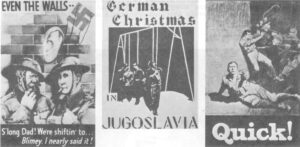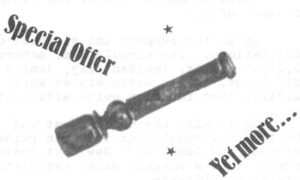Guadalajara, Mexico
The travel posters call it a “Land of Contrast,” but it might be more accurately described as a nation of violent extremes. There is hunger and gluttony, ruthless poverty and spectacular wealth; superstition, ignorance, and racism co-exist antagonistically with a highly-sophisticated intellectual, academic, and artistic elite.
In the mountains of Guerrero, Michoacan, and Chiapas, Leftist guerrillas wage an isolated, seemingly ineffectual, but irksome war of “liberation” against the state. In the streets of Mexico City, right-wing cadres of mercenaries intimidate, sometimes with lethal force, those they consider politically or morally degenerate (the two are usually equated). Freedom of the press is guaranteed, but an editor who strays too far from a stance of centrism or mild reform may find himself unable to obtain paper from the government monopoly controlling that resource. Nevertheless, Marxist and revolutionary publications somehow manage to be published and reach the kiosks.
None of which is to say that Mexico is unstable: those who have most of the butter also have most of the guns. Moreover, with only isolated internal exceptions, Mexico’s “Big Three” — the Church, the family, and the PRI (the only important political party) — are relatively conservative institutions which provide a solid ballast between the extremes. As Fernando Romo, a Guadalajara psychologist, recently commented: “Social and political repression work. That’s what’s so bad about them.” Mr. Romo, who is also a popular disc-jockey, then placed a record on the turntable (John Lennon’s “All I want is the Truth”) and smiled.
The smile may have held irony. With hundreds slain in demonstrations in the past few years, much of the young Left’s energy has been channeled into an emerging Mexican counter-culture. For some, having long hair and dropping-out is the equivalent of “propagandizing by the deed.” And Guadalajara, from which Romo’s, FM program beams, is a microcosm of Mexico’s extremes: reaction and youth-culture survive side by jangled side.
At the Autonomous National University of Mexico (UNAM) in that city, the student body is convincingly conservative. Medical school classes are frequently interrupted for lectures by school administrators on the “cultural subversion” of the country’s “moral fiber” by “undesireable elements.” Those elements, according to one student, are typically identified as Jane Fonda, the Beatles, and “los jipis.”
“It’s strange,” the student added. “You go to class prepared to discuss coronaries and you find out that the morning’s subject is the spiritual threat posed by Miss Fonda.”
UNAM in Guadalajara is faithful to Mexico’s passion for internal contradiction. Its conservatism stands in sharp relief to the more liberal sentiments that prevail in most of the nation’s other universities. Its sprawling campus is surrounded by high metal fencing that is topped by barbed wire. Its entrances are guarded by uniformed police. Dress codes are enforced and long hair is forbidden to men even though most of them are well past the age of consent. A school motto advises that “Dialogue (with the enemy) is cowardly.”
Secret Society
Moreover, the school itself is strongly influenced by a semi-secret society of students called Los Tecotes. That group, according to some disenchanted students, functions as an intelligence-gathering network that monitors their fellow students for subversive thoughts, literature, life-styles, and attendance at Soviet cultural exhibits. The atmosphere at Guadalajara’s UNAM is one of constipated paranoia.
At the same time, the university has more than 1400 American medical students. In fact, the school grants more medical degrees to Americans than most of those situated within the United States. And many of the Americans covertly despise, or laugh at, the conservative bias of the school, conforming to the dress and grooming codes by wearing wigs to classes — short wigs to cover long hair.
“I lead two lives,” one American half-joked. “By day I’m a right-wing nut and by night I’m a degenerate freak.” While some may accept the double-standard, dismissing it with humor, the risks are real. “Let’s face it,” that same student added, “you go here because you can’t get in anywhere else. Not that it isn’t academically sound: it is. But, in any case, there simply isn’t room in American medical schools for all the qualified candidates. If I get kicked out of UNAM — for long hair or talking to a reporter or whatever — I’ll wind up as a chiropractor.” Nor is expulsion the only threat. Another student, de-wigged in a soccer match recently, was repeatedly slapped by other youths and then physically driven from the campus for his deception.
Mexico’s Chicago
And yet, despite the presence of such an important conservative influence, Guadalajara is itself in the grips of a counter-culture spasm sufficiently pronounced that Manuel Aceves is tempted to call the city “our hope.”
Aceves, who describes Mexico as “a pre-fascist society,” is the controversial Editor of Piedra Rodante, Mexico’s Rolling Stone. Articulate and anti-establishmentarian, he has consistently fought censorship and sought ways to free his society from its more constricting traditions. He views “youth-culture” as an international movement inherently opposed to the cult of machismo, nationalism, and social regimentation. Moreover, he considers popular music to be a powerful, potentially constructive, organizing tool. And so, when he calls Guadalajara “the capital of Mexican Rock” he is making an observation that is essentially political.
Just why Guadalajara should occupy that exalted position is not immediately obvious. In addition to the presence of the conservative UNAM, there is a dearth of sophisticated recording facilities. Like most large Mexican metropolises, Guadalajara is the site of both splendid mansions and cardboard hovels. But, on the whole, it is a rather ordinary, business-like place with fewer cosmopolitan pretensions than its rival, Mexico City.
Perhaps as a consequence of its role as Mexico’s “second-city” Guadalajara is peculiarly Mexican. It is capable of nourishing its own traditions without turning them into commodities for tourists, and it seems less affected by foreign influences than is the capital. Indeed, it may be said that if Mexico City is the New York of Mexico, then Guadalajara is this country’s Chicago. And, since Mexico City is unique within its own land, embellished or diluted by European and American influences, it is only natural that an authentically Mexican youth-culture should begin to develop elsewhere, as it has in Guadalajara. And, true to national form, that sub-culture presents a sharp contrast to the larger society.
Calle Escorza
Calle Escorza is one of those Mexican streets that Americans instinctively avoid after sundown. Its length is dotted by dilapidation, crumbling warehouses, and clusters of burly adolescents reading comic-books or simply hanging-around. The temptation is to pretend that you’re Oscar Lewis, or else to leave the neighborhood for a place that is better-lighted, where the language is English, and enthusiasms are politely restrained. But, if you did that, you’d miss a very strange, yet somehow ordinary, experience: a sock-hop of Mexican teeny-boppers churning to the angry rhythms of the Blues (Chicago-style). It doesn’t happen every night on that street, but it occurs daily on others like it in Guadalajara.
Recently, on Calle Escorza, the Blues floated above the heads of more than 1000 young Mexicans gathered in a decrepit warehouse, a battered structure with dirt floors, a corrugated-iron roof, and a collapsed wall.
Five small light-bulbs, the event’s only lighting, glowered inadequately amid rotting beams, and sanitary facilities consisted of an unlighted wall area outside. There was no stage. Four local bands alternated sets from an agreed-upon space in a corner of the building. In a bow to psychedelia, the fiesta’s organizers provided a few paper flowers and two black-lights that didn’t work. Leaning against the walls, policemen squinted with irritation into the shadows, sniffing in frustration at the pungent atmosphere of pot, sweat, and beer.
A rip-off? Hardly. Admittance was $1 for men, free for women, and the beers were 12¢ each. Most of the kids seemed poor, but the grass was freely passed around, and those who couldn’t afford the price of admission entered the warehouse by other means: through the windows, over the walls, or through the roof.
Army surplus, Disney-T-shirts, flowered jeans, work-shirts, and sunglasses were stylish by consensus. An unusual number of young girls were present without chaperones, and took advantage of that fact. The music itself ranged from mediocre to excellent, with one group, called “Chester’s,” playing a highly energetic, reflective blend of hard-rock and Blues. Like the other bands, Chester’s was surrounded by concentric rings of admirers, other musicians, local “heavies,” and hundreds of chavos and chavas in various stages of liberation. A boy with shoulder-length black hair, jeans, and a Sgt. Pepper overcoat, joined the band and solo’ed with his harmonica. His playing was suspiciously reminiscent of Paul Butterfield, but nevertheless inventive: a down-home Blues that would be as readily accepted in a South-side Chicago bar as it was on Calle Escorza. A Mexican youth, hair curling over the shoulders of a torn Eisenhower jacket, turned to one of four Americans in attendance. Passing a joint, he asked, “Fonqui, no?” It was indeed.
It was youth-culture stripped to its essentials, a subversive cement of dissident music, pot, healthy sex and, amid the angry lyrics of the Blues, a sense of togetherness, of good “vibes” that ignored the rigid social roles Mexican society bequeathes to its young.
In an important way, the scene on Calle Escorza was truer to the radically egalitarian roots of youth-culture than most similar ones in the United States. Tickets were one price, and the price was low. Without a stage, a dialogue between the audience and the band was made possible. Indeed, the physical arrangements, or non-arrangements, enforced a kind of democracy among those present. No ushers beat the crowd into submission when it approached the music, nor was there any need to bolster the music with expensive props or elaborate electronic gear. Neither did the bands keep their audience waiting for hours to appear, only to initiate another hour of narcissistic “tuning-up.” Over all, there was a mutual understanding that something unusual was happening, and that, whatever it was, it was important. And yet it was not a commodity that a heavily-bankrolled producer could duplicate. It was, rather, what the rock-group Sly & The Family Stone have called “a family affair.”
Received in New York on May 26, 1972
©1972 Jim Hougan
Jim Hougan is an Alicia Patterson Fund award winner on leave from The Capital Times (Madison, Wisconsin). This article may be published with credit to Mr. Hougan, The Capital Times, and the Alicia Patterson Fund.









